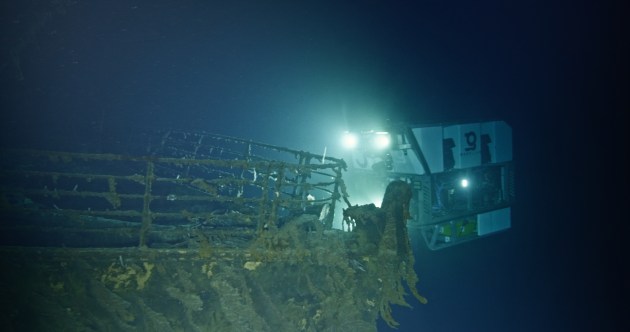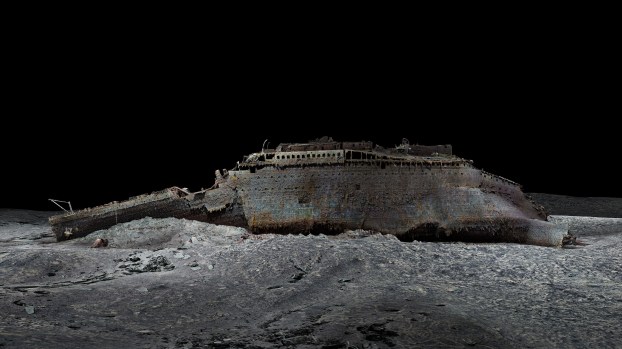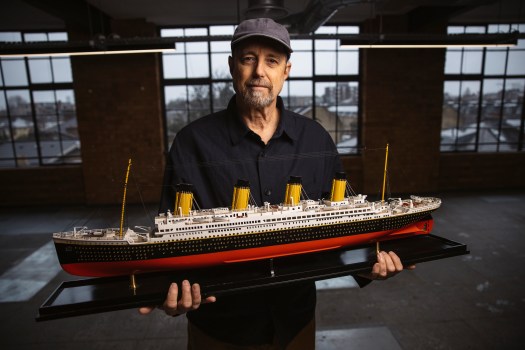Titanic secrets uncovered: Digital scan reveals new details of ship’s final hours
Published 6:47 am Wednesday, April 9, 2025
It’s been more than a century since the ship that was once thought of as unsinkable was lost to the ocean floor during her maiden voyage.
Because the Titanic’s wreckage is so large and lies in the gloom of the deep, exploring it with submersibles has only shown small snippets of what may have happened to her during that ill-fated trip. That all changes now.
After nearly two years of research, experts have been able to create a full-scale, exact “digital twin”of the ship providing the first full view of the Titanic and her debris field since the ocean liner ripped in two as it sank in 1912.
Their efforts are captured in a new documentary by National Geographic and Atlantic Productions called “Titanic: The Digital Resurrection,” which can be streamed on National Geographic, Disney+ and Hulu beginning April 11.
“Titanic is the last surviving eyewitness to the disaster, and she still has stories to tell,” said Parks Stephenson, a Titanic analyst featured in the film who gave the American Press an advance interview ahead of the film’s premiere.
A semi-fresh transplant to Baton Rouge, Stephenson is also the executive director of the USS Kidd Veterans Museum.
Louisiana “is a lovely state and I love the music and the food,” Stephenson said. “In fact I have gained so much weight since I’ve moved there in the last two years I’m having to buy clothes to wear because I don’t fit in my suits anymore.”
A graduate of the U.S. Naval Academy with a bachelor’s degree in naval science and Auburn University with a master’s degree in political science, Stephenson dedicated 20 years to active-duty service in the U.S. Navy, followed by 27 years in the aerospace engineering industry.
“I was always destined to go into the military,” he said. “Going to the Navy, going to the sea, that was always the thing for me and I stayed in for the career. Once I had to leave it, I fell into the defense aerospace industry because I had no skills outside the Navy so what do you do? You go and you develop these systems that you operated on in the Navy and use your operational expertise to fine-tune those.”
Stephenson said he left that job after working on the deep-ocean wreck of the USS Johnston. The destroyer was sunk by the Japanese navy on Oct. 25,1944, during the Battle off Samar.
“The wreck really hit me emotionally and I quit that career and took the job in Baton Rouge to take care of her sister ship, the USS Kidd.”
Stephenson said he’s been a Titanic enthusiast since he was a boy.
“I remember watching as a child the 1953 ‘Titanic’ movie on TV and was enraptured by those scenes and throughout my teenage years I pursued Titanic history,” he said. “There were other historical subjects that fascinated me and I’m still following them, too, but Titanic was the primary one. I did nothing during my time in the Navy because that was all-encompassing and by the time I got out of the Navy in the late 90s, Jim Cameron was making the movie ‘Titanic’ and the Internet was the thing and those two kind of conspired to elevate me to a higher level of Titanic research.”
Stephenson would ultimately serve as a technical advisor to Cameron on various Titanic-related projects, solidifying his position as a leading authority on the ill-fated ship.
During a trip to the Titanic wreckage in 2019, Stephenson met Anthony Geffen, who would go on to produce “Titanic: Digital Resurrection” for Atlantic Productions. The pair said the Titanic has been extensively explored since the wreck was discovered in 1985, but in the gloom of the deep, cameras can only ever capture snapshots of the decaying ship — never the whole thing.
“It was a big deal going to the Titanic,” Geffens said. “One of the things I realized when we did that was it’s very dark down there, you can’t see very much and all the other explorers had always been limited by what they could really tell from the Titanic because it’s very murky. That’s when I had the idea that I wanted to scan the Titanic so that Parks and his team could really do research that had never been done before.”
Geffen said exploring the ship has often led to more questions than answers.
“I remember sitting on the deck of the ship and feeling the only way to answer those questions was to scan it,” he said. “We formed an alliance with Magellan, who had the technology to do it, and scanned it. It took a long time for it to be pieced all together because the data is huge. Parks and his team have been working on it for over a year. It’s a huge site. Think about it, Parks is going out there on a site that’s 13-by-13 miles, if not bigger, looking for clues.”
Stephenson said expeditions are very expensive and there’s a lot of investment that goes into every single dive.
“I am obviously not rich and I don’t have money to do this so what I do for the good of the mission, for the good of the expedition is I gather data,” he said. “As soon as I’m down there, as soon as I touch down on the bottom, I am eyes out and I’m looking for anything I can and I focus so intently on data acquisition that there really is no emotion. I kind of push the emotion aside.”
Stephenson said Geffen’s idea for the scans “opened up my world outside my viewport.”
“Can you imagine scanning something at 4,000 meters in the dark on hundreds of dives? That’s unheard of, but we did it,” Geffen said.
Stephenson couldn’t hide his enthusiasm in the film when Geffen projected the scans of the Titanic around him in the studio.
“That was like standing on the ocean floor, looking up at the Titanic, well-lit. You could see wherever you wanted to look and you did not have the confines of the submersible around you. That’s where real analysis could take place.”
Stephenson said there have been questions bugging him for decades about the ill-fated ship. Some were answered by the scans, some remain.
“It did open up new lines of inquiry that is going to be vexing for many years to come,” he said. “Or I’m going to turn it over to the next generation of researchers to grapple with. This technology, I’m convinced, is the way of the future for deep-ocean exploration. Not just Titanic and not just shipwrecks. It could be geological. We need to understand the ocean bottom.”
The deep ocean bottom is the next frontier, Stephenson insists.
“There’s so much of our future linked to the bottom. We’re talking about our green technology, all of those rare Earth minerals that are starting to dry up from terrestrial sources. There is an abundance on the ocean floor. As with anything, if you go after that too aggressively you start to affect the environment in a negative way,” Stephenson said. “We have to understand the deep ocean environment so that we can exploit it responsibly. This technology is the first step in that.”
Stephenson said his time post-Navy as an aerospace engineer really changed how he thought about the Titanic.
“It gave me some skills to evaluate some things from an engineering perspective,” he said. “I remember that one of the scans Atlantic sent to me was of the stern section. We’ve always talked about how the stern section is in so much worse condition than the bow section and why is that? As soon as I saw that first render — and this was early in the process and they would continue to refine it — I could just instantly see from an engineering background what happened to the stern.”
Stephenson said the extent of the wreckage shown by the scans was jarring because the scans remove the human bias and romanticism that has been associated with the Titanic. They also provide a new view of a boiler room, confirming eye-witness accounts that engineers worked right to the end to keep the ship’s lights on, and the porthole window smashed by the iceberg.
“The people in the boiler room, they were the real heroes,” Geffen said.
The Titanic “is one of those odd moments in history that fascinates us,” Geffen said. “It’s something that happened out there that nearly didn’t happen. It happened in a very romantic period, in a way. The Titanic was this great frontier of travel of new ships and it just has someone captured our imagination and I don’t think it’s ever going to go away. This will only increase it.”
Stephenson said the Titanic will not give up her secrets easily.
“Every time we go down there, we uncover the evidence, we listen to those stories and we piece it together and I swear every time we go down there we answer some questions but we raise more. It’s never-ending. Every time we go down there, the accepted Titanic narrative gets challenged again and again and again.”








